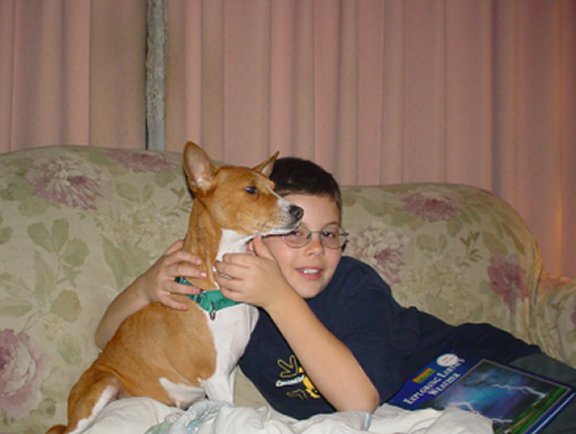
The Story of Mirrie's Spay Surgery

I need to begin this story with a caveat: The moral of this story is NOT "do not spay your matron bitch." There are MANY well-documented benefits to spay surgery, and there are many situations and health concerns (both potential and actual) that make spay surgery something to consider. The moral of this story is: Do NOT proceed with spay surgery for a matron bitch without being fully informed about the risks involved, and without weighing those risks against the potential benefits.
Mirrie is my foundation bitch. She has given me two handsome litters -- eleven beautiful, healthy puppies. After her final litter in 2001, I decided that I would not breed her again, but would instead turn the whelping box over to Mirrie's daughter, Dulcinea. Like most of us, I hemmed and hawed, and put off actually scheduling a spay surgery for Mirrie... But finally, I selected the date - February 12, 2003. If I could go back in time, and review that decision, I would make a different one. Here is the story of how Mirrie very nearly lost her life to a "routine" spay surgery...
On the morning of February 12, Aaron and I got up early to make sure we had plenty of time to get him ready for school, AND to get Mirrie to her scheduled spay surgery with my regular vet. Our efforts at timeliness paid off, and I dropped Mirrie off at my vet's at 9:00 a.m. She was spayed at 11:00 a.m. -- and my vet called to tell me she had done beautifully, especially for an older girl. There were no signs of any kind of pathology, no unusual bleeding, etc. I picked Mirrie up at 4:15 p.m and she came out to meet me looking good -- wagging her tail, trying to jump up on me, the vet tech, etc. I walked Mirrie to the car, put her in her crate, and drove home. That's the LAST thing that would be "normal" or "typical" about Mirrie's spay surgery.
I pulled into my driveway, got out and walked around to take Mirrie from her crate. I opened her crate and reached in to get her - and saw that she was sitting in a pool of blood! I took her out and put her on the ground -- and a circle of snow beneath her turned red, spreading a good 8" as I watched. She was hemorrhaging. I rushed her into the house, holding onto her with one hand, and dialing the phone with the other... I probably shouldn't even have taken the time to do THAT -- but my vet told me I must get her to an ER vet as quickly as possible. She also told me I had to put pressure on the incision -- which was now spilling blood like water from a faucet. I ran to the bathroom, folded a bath towel, and grabbed a pair of panty hose from a drawer to use to tie the towel to Mirrie's belly . By the time I got back to the kitchen, she was staggering, and collapsed onto the floor. I tied the towel as tightly as I could, ran back to the car and ran every light and stop sign to the ER clinic - which is about 15 minutes away.
When I got to the clinic, she was gray, and not responsive. I got her into the clinic (blood EVERYWHERE....) and the receptionist rushed to help me with her - asking if she'd been hit by a car. I told her "No, she was just spayed this a.m., and she's hemorrhaging..."
Mirrie went directly from my arms to yet another surgery. The reports from surgery were not at all good. She had lost over TWO PINTS of blood - and was still bleeding out. Thankfully this ER clinic had blood collection and self-transfusion supplies at the ready -- before the surgery was over Mirrie would be transfused twice with her own blood. She was in surgery for over an hour. Twice, the head vet of the clinic came in and told me that he did not expect her to live -- she'd been bleeding internally for HOURS and he felt she'd simply lost too much blood to make it. The surgery disclosed the cause of the bleeding -- a large soft tissue "tear" were one of her ovaries had been. Was this an error by the vet who did the spay? Or had Mirrie done this herself, hopping around in my vet's kennel waiting for me to pick her up? We'll never know the answer to that question. Finally, the bleeding was stopped - but things still looked bad. Mirrie's body temperature was only 91 degrees. I was told there was a good chance that although she was alive NOW, she would not make it through the night. Aaron and I slept in our clothes - but I never actually closed my eyes...
As the night wore on, however, the calls from the ER overnight clinic were progressively more hopeful. In fact, the ER vets could not BELIEVE how quickly Mirrie was improving. Her body temp rose from 91 degrees at 7:00 p.m. to 99 degrees at midnight (and to 101 by the following a.m.). Her blood protein had been terribly low (due in part to all the IV fluids pumped into her, plus the blood lose) but rose steadily as the night went on. She sat up. She stood up (even though she was full of metal staples inside and out). THEN, around midnight, the reports became REALLY positive:
"Mirrie has chewed through the IV set..."
"Mirrie has chewed through the hot water blanket tubing...."
"Mirrie has chewed through the Elizabethan collar I [the ER vet] put on her to keep her from chewing the IV set, and she chewed another IV set!"
While I had to PAY for all that chewing -- I knew she was doing MUCH better... So did the ER vet.
To cut to the chase, I was able to bring Mirrie home (much to the dismay of the ER staff) on Thursday afternoon. She is doing very well and seems more like her "old self" every day - sleeping less, eating more (her appetite is basically back to normal), etc. Her blood protein levels had returned to normal as of 2/16/03 and it DOES appear she is out of the woods at this point.
IN THE END: I will never again spay an older bitch who doesn't REQUIIRE spay surgery for some reason (pathology, etc.). I sent a healthy, happy 8 yr. old girl to surgery, and a few hours later, she was literally at death's door. I realize that there is no such thing as routine surgery - however, what I did NOT KNOW and what I know now (from my conversations with the ER clinic staff) is that these kinds of life threatening complications are NOT as uncommon as we might like to think... And that spay surgery on an older bitch who has had litters is a FAR MORE risky surgery than spaying a puppy or a young bitch who has not had litters. Apparently the vascularity of the entire area of the uterine horns and ovaries makes hemorrhaging a FAR greater risk for matron bitches. The ER vet told me that a "surprising number" of older bitches are lost during/immediately after spay surgery every year. If I'd known this, I would never have made the decision to have Mirrie spayed. I simply thought it was "the right thing to do" since I no longer intended to breed her (turning the reigns over to her daughter, who is five). Famous last words...
In case anyone is wondering, nothing in Mirrie's blood work up indicated any kind of clotting or bleeding problem. Her pre-surgery blood panel was (per my vet) "text book perfect".... Her platelets were normal and per the ER vets, her clotting time was completely normal. It was the somewhat mysterious tear into the soft tissue near the site of her left ovary that caused the bleeding -- and very nearly took her life.
LESSONS LEARNED: IF I were ever required to spay a matron bitch again in the future, I would do the following, based on my experience with Mirrie:
1. I would do a BOTH a full pre-surgical blood panel AND a coagulation panel. A coagulation panel is not cheap - it is presently about $85. However, IF a bitch WERE to have a problem with platelets, etc., THIS test would reveal it. A routine blood panel might NOT. Mirrie did not have a coagulation problem - but she easily could have. None of the tests we did prior to surgery told us that fact, conclusively.
2. I would use ONLY a board certified surgeon. A general practice vet is probably a fine choice for spaying puppies, or bitches who have never had litters. Using a board certified surgeon to spay Mirrie would have cost me about $500-$600 (a routine spay in my area costs about $175). However, compared to the $2,000+ bill I received from the ER clinic and emergency overnight facility, $500-$600 seems downright cheap! Not to mention the toll this incident took on Mirrie's 8 year old body...
3. I would make sure that the surgeon understood that this was a matron bitch, and that I was very concerned about the risks of hemorrhage after the surgery. Preferably, I would want the bitch to stay through the first night after surgery in 24 hour Emergency care (which is offered by my local veterinary specialty clinic) so that her condition could be monitored around the clock for a full day after surgery.
This was a very frightening close call for my family. Mirrie - and what she contributes on a daily basis to our household - is hard to describe. Those of you reading this who have had wonderful foundation bitches and brood bitches over the years will understand what I mean. Mirrie is a quiet girl - one who rarely demands any attention for herself. She was a truly marvelous dam -- an easy whelper whose devotion to her puppies came closer to the definition of "selflessness" that anything I've witnessed in the human realm. She is the matriarch of our household (except for me, of course!) -- and she is a natural leader -- quick to discipline if necessary, but also quick to forgive. To have lost her to a SPAY SURGERY seems incomprehensible. Unthinkable! But that is precisely what almost happened on February 12, 2003. If it could happen to Mirrie, it could happen to any matron bitch. Be informed about the risks, and weigh them accordingly. I don't feel I did that for Mirrie - and ultimately it was Mirrie who had to pay a very high price.
Karla Schreiber
New World Basenjis

Mirrie recovers from her ordeal - February 15, 2002.
[The stress of the surgery caused Mirrie to lactate - she was
NOT in a false pregnancy when she was spayed)...
![]()
|
| |
|
|
Copyright Karla A. Schreiber, 2003